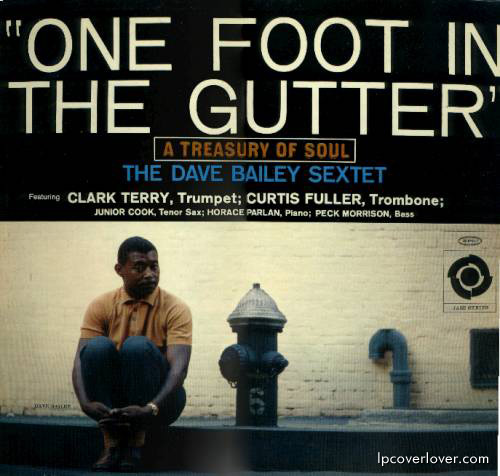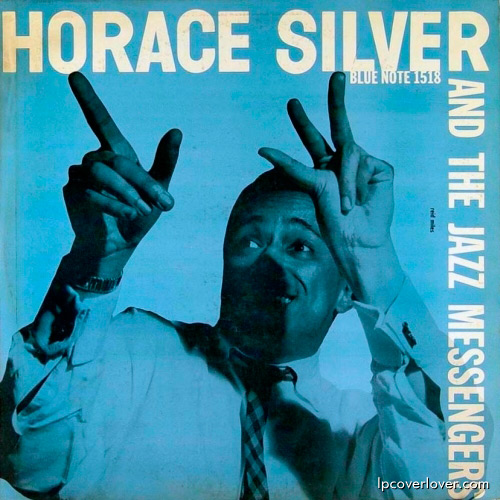The Joy of Sax
Sax Sounds. Apollo Records. 1950’s jazz saxophone compilation with amazing graphics.
Your search for jazz cover returned the following results.
Sax Sounds. Apollo Records. 1950’s jazz saxophone compilation with amazing graphics.
Storyville presents Jackie and Roy. Burt Goldblatt design. (1955)
It’s hard to go wrong with the jazz vocals of husband and wife team Jackie & Roy. After joining forces in 1946, they joined Charlie Ventura a couple years later. Shortly after leaving Ventura in June 1949, they were married and worked together on a regular basis for the next fifty years. Jackie and Roy had their own television show in Chicago in the fifties, worked in Las Vegas during 1957-1960, and settled in New York in 1963. Working in a mode that was deeply informed by bop, Jackie and Roy hit vocal lines that only the hippest of the fifties singers could match. Some cuts on this Storyville 10″ feature scatting, others vocalese, and still others just great straight-up readings of the lyrics. The small combo features Roy on piano, Barry Galbraith on guitar, Bill Crow on bass, and Joe Morello on drums. Titles include “Slowly”, “Thou Swell”, “I Didn’t Know What Time It Was”, “Cheerful Little Earful”, “Hook Line & Sinker”, and “Yesterdays”.
Having raided and fully absorbed my step-father’s one cabinet of records as a kid, I was familiar with a couple Jackie and Roy records growing up. Listening to songs like “Spring Can Really Hang You Up the Most,” “Let’s Take a Walk Around the Block” and “You Smell So Good” didn’t win me any friends and fewer dates.
Thelonious Monk Plays. Prestige Lp 189 with Percy Heath and Art Blakey. (1954 Session). Tracks are: “Work”, “Nutty”, “Blue Monk”. “Just a Gigalo”.
Work — Only recorded once, in a trio setting on September 22, 1954 (Prestige PRLP 189), Work is a dissonant, difficult, wild melodic ride that artists have been willing to take. The title speaks for itself. Besides Monk’s version of Work, for which he alone is responsible for stating the melody, one of the few musicians to take up the challenge was soprano saxophonist Steve Lacy, who recorded it on his debut album (Prestige 7125) in November of 1957
Nutty — First recorded on September 22, 1954, in a trio setting with Percy Heath (bass) and Art Blakey (drums), “Nutty” was among Monk’s more popular tunes. Perhaps the most famous recording of it is with John Coltrane, July 1957 (Jazzland JLP[9]46). A few writers have strangely tried to link the title to Monk’s alleged state of mind (!), but any such claims betrays an ignorance of the “hip” lingo of the day. In the 1940s and 50s (and even later), “nutty” commonly meant “excellent” or “cool” -like “insane,” “mad,” and “crazy.
Blue Monk — Monk recorded “Blue Monk” more than any other composition besides “”ËœRound Midnight.” His first recording dates back to September 22, 1954 (Prestige PRLP 189 LP7027). Abbey Lincoln added lyrics and recorded it under the title Monkery’s the Blues. Monk himself was summoned to the studio to hear Lincoln’s version and to get his blessings. He approved.
In the early 1950s Monk recorded four albums for Prestige. In 1953 Prestige released two 10-inch LPs, Thelonious Monk Trio (PRLP-142) and Thelonious Monk Quintet with Sonny Rollins and Julius Watkins (PRLP-166), the latter his trio (with drums and bass) augmented by Rollins’ tenor sax and Watkins’ French horn. In 1954 Prestige released two more 10-inch LPs, Thelonious Monk Quintet (PRLP-180), and Thelonious Monk Trio (PRLP-189). The material on these four 10-inch LPs was repackaged and reissued by Prestige on a series of 12-inch LPs in 1956 and 1957 (Thelonious Monk, PRLP-7027; Monk, PRLP-7053; Thelonious Monk/Sonny Rollins, PRLP-7075), which were themselves reissued with new titles and catalog numbers starting in 1959 and continuing into the mid-1960s (as Monk’s Moods, PRLP-7159, a reissue of 7027; Work, PRLP-7169, a reissue of 7075; and We See, PRLP-7245, a reissue of 7053). (We See was later again reissued as The Golden Monk, PRLP-7363; Monk’s Moods as The High Priest, PRLP-7508; and Work as The Genius of Thelonious Monk, PRST-7656 ““ in “electronically rechanneled” fake stereo.)
Notes courtesy Robin D.G. Kelley.
Moog Indigo Created by Jean Jacques Perrey. Vanguard Records. (1970)
After establishing himself at the vanguard of electronic music as one half of Perrey & Kingsley, Jean Jacques Perrey continued to pursue his own uniquely space-age brand of humor-oriented pop throughout the 1970s. One of the best examples of his work during this time is Moog Indigo, an album built around Perry’s experiments with the Moog synthesizer. This album has been popular with the electronica crowd thanks to the presence of “E.V.A.,” a funky synth excursion that became popular with remixers (Fatboy Slim turned in a memorable remix of this tune on Best of Moog). The remainder of the album divides its time between funky lounge-pop and experimental tracks that mix avant-garde electronics with novelty pop. One of the big highlights in the lounge arena is “Soul City,” a funky instrumental where Moog synthesizers take the place of horns in a guitar-heavy slice of R&B. There is also a swinging take on “Hello Dolly” that sounds like cocktail jazz from another planet. As for the strictly novelty-styled tunes, the most memorable is “Gossipo Perpetuo,” a clever tune that mixes tape loops designed to sound like chattering voices with a fast-paced synthesizer samba groove to create a genuinely smile-inducing slice of novelty pop. Serious electronic music fans may find Moog Indigo’s humor-oriented style too lightweight, but everything presented here is tight and catchy and there is no denying that Perry has assembled his songs with amazing technical skill. In the end, Moog Indigo is a solid pick for lounge fans with a sense of humor. ~ Donald A. Guarisco, All Music Guide
An incredible record of funky moogy grooves — possibly one of the best of the genre! Jean Jacques Perry really outdid himself on this record — going past the simple cut ups of his work with Gershon Kingsley, and hitting a style that was more groovy, and more song oriented. The best example of this is the album’s fantastic funky tune “EVA” — a monster break/moog cut that’s been sampled by Gang Starr for “Just To Get A Rep”, and more than a few other artists over the years! The rest of the record’s just as great — and cuts include “Soul City”, “18th Century Puppet”, “Gossipo Perpetuo”, and “Passport To The Future”. — Dusty Groove America
“Shock Treatment” The Mel Henke Group on Tempo Records. Nice red vinyl on this one.
Tracks include: Cocky Cuckoo Clock; Pennies From Heaven; Paradis Toccata; In A Mist; Little Rock Getaway; Frenzied Flight; Shock treatment; I Surrender Dear; Dance Of The Cavemen; Kakachurian Toccata; I Can’t Believe you’re In Love With Me; In A Little Spanish Town
Coming up in a variety of Chicago bands in the ’40s, this pianist had an unusual career that included recording downright weird tunes such as “Shock Treatment,” “Cocky Coo-Coo Clock,” and “Frenzied Flight,” as well as creating what might be one of the masterpieces in the genre of lounge music, although experts in this style have been a bit relaxed about establishing an exact opinion. Henke shows up in the rhythm section on some Louis Armstrong records, and meanwhile over in Nashville, he once successfully placed a song with Conway Twitty. Henke was trained to please in writing ad copy, an influence that has been considered both a pro and con factor in his recorded works. Perhaps Henke’s greatest influence as a musician was in the advertising field itself, as he was innovative in mixing music and sound effects as an attention-grabbing factor in the commercials of the ’60s.
By the early ’40s he had settled in Los Angeles, leading his own trio on the side. This outfit landed a deal to make a pair of albums on the Contemporary label, which is where jazz buffs inevitably come across him. Fans of the type of challenging jazz often presented on this label may find the concoctions of Henke a bit bubbly; his followers seem to drift in more from the aforementioned loungey or space age waiting rooms. In 1955 he went to work for Disney’s television department, writing material for a great deal of the studio’s commercials as well as incidental music for the Disneyland television series. Henke ran his own production company as well, and was known for experimenting with sound effects and the concept of mixing dialogue into musical passages. Inevitably, he created a series of albums combining these techniques with full-length musical performances and instrumental skullduggery. La Dolce Henke, worth hunting down for its title alone, is considered his masterpiece. – Eugene Chadbourne, All Music Guide
Jazz great Bucky Pizzarelli’s Quartet on Savoy Japan. “Midnight Moods”
The World’s Most Marvelous Mechanical Invention = “The Fantastic Jazz Orchestra” !!

Here’s a great jazz album! “One Foot in the Gutter” by The Dave Bailey Sextet on (Columbia) Epic Records. The lineup here is amazing with Clark Terry on trumpet, Junior Cook on tenor, Curtis Fuller on trombone, Horace Parlan on piano, and Peck Morrison on bass. The songs are: One Foot In The Gutter; Well You Needn’t; and Sandu. Blue Note, Riverside and Prestige weren’t the only labels putting out driving, hard bop jazz classics in the early sixties. In addition to this try Bailey’s “Two Feet and the Gutter” and “Gettin into Something” also on Epic.

Horace Silver with the Jazz Messengers Blue Note 1518. Hard bop prophets at the birth of the movement. This is Silver’s first session as a leader. The year is 1955 and it’s the start of an incredible 15-year run of stunning musical achievement from Blue Note Records. KENNY DORHAM, trumpet; HANK MOBLEY, tenor sax; HORACE SILVER, piano; DOUG WATKINS, bass; ART BLAKEY, drums. The eight original Silver compositions, including “The Preacher”, “Creepin’ In” and “Doodlin'”, are jazz standards today. Reid Miles designed the cool cover. Blue Note founder Alfred Lion took the photo. Ira Gitler wrote the liner notes. Rudy Van Gelder mastered.
“Jazz on the Bounce” with (Buddy) Collette and (Curtis) Counce. A Bel Canto Stereophonic Record.